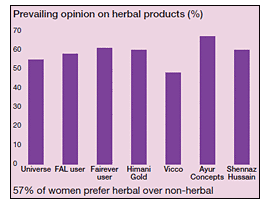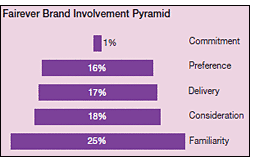
Understanding brand equity can play a vital part in formulating media plans. Sheila Byfield introduces MindShare's proprietary tool, 3D.
According to Millward Brown, 70% of the financial value of the world's leading brands driven by emotional attributes - brand equity. Across countries and product categories, a disproportionately small number of customers account for the vast proportion of brand profit. All companies recognise the value of loyal buyers and the need to preserve their commitment. As product differentiation becomes more difficult to achieve, it is often the emotional rather than the functional values that drive brand sales. If money were no object, people time and time again would choose those brands with which they have the greatest affinity. As a result, there is an increased need to identify highvalue customers and to communicate effectively with them.
Marketers have a wide range of brand equity studies to help achieve a better understanding of their brand's values and the direction to exploit them. But while these studies are invaluable for guiding creative executions, they provide very little information on either the lives of high-value customers or, more importantly, the means through which to reach them as they do not include any media dimensions.
3D is a proprietary study designed to close this gap in the circle. At its heart is a brand equity study based on the techniques used in Millward Brown's BrandDynamics study. This is combined with social values and media consumption to provide a single source of critical insights necessary for effective communications strategies. Through it, advertising can be directed towards target groups who are important to the category and add more profit to the brand.
3D was first launched in the UK in 1999. Since then, it has extended into 20 other countries and surveyed over 80,000 people.
Case study: Fair and Lovely
Extending a brand to a new target audience.
MindShare India
You may need to learn some new words to understand this case study.
Allopathy - modern medicines, the world of antibiotics etc.
Ayurveda - Indian medicine from pure herbal extracts. Also includes other beliefs, e.g. an important part of Ayurveda is astrology.
Fair and Lovely (FAL) is a skin lightening cream and is the undisputed leader in its sector. To grow further, it needed to reach out to a new customer base. One group who were not persuaded by FAL were those who prefer natural products. FAL, therefore, launched an 'ayurvedic' variant to appeal to this group of women.
The brand proposition suggested that potential target groups would be attitudinally driven and that demographic targeting would not yield meaningful results. Therefore, extensive 3D analysis was conducted to understand the attitudinal and behaviour characteristics and communications opportunities among this untapped source of potential business.

The objectives of the launch were:
- To target the large base of consumers who currently use home-made remedies and perceive them to be better
- Attract users from Fairever - a competitive fairness cream that stresses natural ingredients and to which some FAL users had switched
- Attract users from other skin creams selling on a herbal platform
- Increase share of the total skin creams market to 6%.
3D was able to identify the most likely candidates for the new brand through attitude statements relating to skin care. For example:
- 57% of women prefer herbal to nonherbal face creams. This indicates that few would have a negative reaction towards the variant's new 'natural' proposition.
- 40% of women and 55% of FAL users believe that Allopathy is harmful.
A primary task, therefore, was to convince potential buyers that the category is relevant to them.

The Brand Involvement Pyramid for the main competitor was also examined to identify women at the lower levels. This group was identified as a target group as they had a relationship with Fairever but had not committed to it and, therefore, may be vulnerable to competitive messages. Many are also lapsed users of Fair and Lovely and so would not be total strangers to the brand name.
A two-tier communications solution was recommended.
- Setting the agenda: persuading people of the relevance of Ayurveda
| • | A PR print campaign prior to the brand launch demonstrating the relevance of Ayurveda to modern day living. |
| • | TV 'content' campaign to generate interest in Ayurveda. This included leading actors in serials talking about their Ayurvedic 'sign' and its impact on their personality. |
| • | TV personalities frequently mentioned a 'miracle' ingredient called Kukkumadi tailam which was to form part of the brand communication. Actresses prompted viewers to find out their sign and understand themselves better. |
| • | A contest where viewers were asked to match TV stars with their Ayurvedic signs. |
- The brand communication
| • | Advertorial to establish a better understanding of the benefits of Ayurveda-focused products. |
| • | Advertising which was changed from the usual demographically-targeted campaign to reflect the behaviour of the new target groups. |
| Medium | Conventional | 3D plan | Savings |
|---|
| Television | 336.0 | 308.0 | 28.0 |
| Print | 130.0 | 67.7 | 62.3 |
| Total | 466.0 | 375.7 | 90.3 |
| Savings % | | | 19.38% |
The new strategy differed considerably from the previous conventional plan. Prior to the 3D there was an equal weight between terrestrial and cable/satellite TV, daily newspapers played a lead part in the print plan and the campaign was restricted to brand-only advertising. The 3D plan led to a switch to cable and satellite TV and magazines instead of newspapers. But the biggest change was the introduction of the Ayurveda agenda-setting programme that included advertorials and an intensive PR campaign to complement brand advertising.
Better targeting through 3D not only resulted in effective planning but better and more efficient budget allocation. The 3D plan delivered a phenomenal 19% saving as it used only 81% of the budget required for the original plan.
But the real pay-off was the brand surpassing Fairever and becoming number two in the market in just nine months.
Source: Atticus 10 (2004), p14